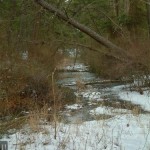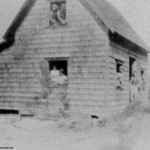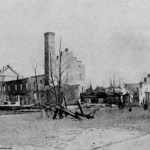The fire came without warning. Sweeping through the area, it engulfed the mostly abandoned village. Flames licked through the mill like it was candy. Large wooden supports, now dried, weakened, and blackened, gave out and with a crash the roof caved in. The remaining buildings were soon gutted – the village itself totally destroyed. A calm quiet filled the village the next day as the last people who hung on after the mill closed sifted through the charred remnants of their homes, filled their wagons, and turned their back on the place they had called home. No longer would the chorus of hymns be heard from the church. No longer would the playful laughter of the campers from the Atlantic City YMCA be heard on the lake. Except for someone passing through on the way to Chatsworth or Green Bank, the village lay totally empty – stone spires and charred timbers the only witness to one of the most successful of the Pine Barrens towns – Harrisville.
Before Harrisville was called Harrisville, it was McCartyville. Before that, the place was likely named after some of the many entrepreneurs that started operations there. The first mills started near the site that would later be known as Harrisville were a combination saw and grist mill founded by Evi Belangee, Jr. between 1750 and 1760, and the Wading River Forge and Slitting Mill, founded by Issac Potts in 1795. Potts, who also founded nearby Martha Furnace two years prior.
Martha Furnace was a large iron blast furnace a located short distance up the Oswego River from Harrisville. At it’s peak, the furnace supported nearly 400 people in the town proper as well as the nearby town of Calico. Pig iron was the chief product of Martha, although larger items such as firebacks, stoves, sash weights, etc. were also produced. There was a demand for finished goods, and as more and more settlements were built in the Pine Barrens nails became a hot commodity. Recognizing this, and the fact that there was abundant water power nearby, Potts erected his forge and slitting mill to process pig iron from Martha as well as nearby Speedwell furnace.
Potts was more of a real estate speculator than an ironmaster, and in 1797 sold the forge and slitting mill to George and William Ashbridge and Joseph Walker. A few years later he sold Martha Furnace itself. Hard times were descending quickly on the iron industry in the Pine Barrens, and the property changed hands often. Around 1832 William McCarty, Thomas Davies, and Issac Ashmead became the latest in a long series of owners of the site.
The writing was on the wall for the iron industry in the Pine Barrens. Knowing that it would be foolish to continue operating the slitting mill as furnaces nearby were closing down, McCarty and Davies turned their attention to paper after McCarty bought out Ashmead’s interest in the property. In 1834 they obtained a mortgage for $10,000 and began work on a new mill to produce paper.
Work began on a canal to divert water from the old mill pond (now Harrisville Lake) to a new mill built a short distance from the lake. This canal, designed and engineered by McCarty, ran for just over three-tenths of a mile and was dug entirely by hand labor. Fortunately labor at that time was plentiful, as there were many unemployed iron workers. Workers were paid 9¢ per hour to dig the nearly fourteen foot deep canal. In addition to the main canal, a smaller canal was dug to power the grist mill and a saw mill. This smaller canal was a diversion from the main canal and reconnected with it before it crosses modern day Rt. 563.
Paper was made from salt hay harvested from nearby meadowlands. Wagons arrived daily with new loads of hay, as well as loads of scrap paper, rags, and other old cloth products from New York or Philadelphia. Rags and old cloth were sorted, cleaned, and buttons, seams, and metal fasteners removed. This material was then sent through a rope cutter machine that reduced the material to shreds. This raw material was then wetted down and dumped down a chute into the prepared stock house. From there the stock would be brought to two stone vats in the main mill to be boiled and reduced to a pulp with rotating knives. Later, in the Harris era, these vats were no longer used and the stock brought to the rotary boiler room, where chemical action replaced the knives. (Incidentally, the paper factory at Harrisville was likely the first water polluting industry in the Pine Barrens. After cooking the pulp in the boilers, the excess waste water and acids were dumped directly into the mill tailrace.)
The salt hay itself was processed differently. The hay was brought to the bleaching house, located at the southerly end of the mill. It was cooked with soda ash in large tubs. Then it was washed several times and brought to bleaching tanks. The stock was then boiled with lime and chlorine, which further reduced the hay to pulp. Then the pulp was washed again and beaten with knives to the required consistency. Until the pulp was used to make paper, it was held in stuff-chests, which were wooden tanks that were constantly agitated to keep the pulp from settling. This also helped further clean contaminates out of the pulp that may have remained from the bleaching process. From here, the pulp was pumped to the paper making machines.
The pulp was fed into a machine which agitated and matted paper on a continuous belt screen. The paper moved through this machine at a rate of 20 feet per minute. A press squeezed the remaining water out of the pulp before it was pressed under a series of rollers. The paper then traveled up through the machine to the second floor of the mill where it was fed into the sizing machine. The sizing machine starched the paper. Finally, the paper was passed under a polished iron roller known as a glazing calendar that provided a final finish to the paper and added strength.
The paper produced was 30 inches wide, and was sold in either rolls or cut sheets. There was a power cutter that would cut the paper to required lengths. The paper would then be lowered out the Southern end of the building to barges. Around 1861 the paper was hauled by mule train to Harris Station, 11 miles away, near Hampton Furnace to make the trip by train to market.
McCartyville, as it was now known, grew prosperous very quickly. In addition to the paper mill, which was one of the most advanced in the country at the time, a grist mill, two sawmills, and a company store were also built. This store generated a profit of nearly $3,000 annually. To house his workers, McCarty built several cottages a short distance away from his mill. He also constructed a dining hall and dormitory, where workers could have a hot meal each night in exchange for a weekly fee taken from their pay. Across from this dinging hall, McCarty built himself a fine mansion. Plans were drawn up for a second paper mill to further increase output.
Disaster struck in November of 1846. A fire broke out at the paper mill and heavily damaged the building. In 1847 the Wading River Manufacturing and Canal Company, as McCarty’s enterprise was called, repaired the building and began processing paper again. However, the financial strain of rebuilding the mill was too great for the company to survive for long. The property was sold at a sheriffs sale. McCarty was able to buy back one quarter interest in the property, but at this point in time it was too late. The mill was idle, and McCarty sold his interest in the property to Thomas Albert Haven.
On May 1, 1851 Richard Harris and his brother Benjamin gained control over the property. There were some legal problems that did not get resolved until 1855 due to the death of Thomas Albert Haven and his heirs subsequent wrangling over the property. In 1856 the Harrises obtained a mortgage for $7,552.86 from John H. Simon who controlled the remaining 3/4 of the McCartyville property. Simon agreed to finance the Harrises purchase of the property if they offered their own quarter as security. The Harris brothers agreed, and on November 2, 1856 finally had full control over the property. By 1858, several other Harris brothers and their father bought and sold interests in the property. Around 1858, after the mill had been put back into operation, the sole owners of Harrisville, as it was now known, were Richard and his father John. John, however, only wanted to offer financial and management assistance to the company. The real leader behind Harrisville’s day to day activities was Richard. John Harris retired from the company in 1866 and returned to his native Philadelphia.
Harrisville went through a period of rapid expansion. In 1858 Harris obtained a mortgage for $12,000 and paid it back within 5 years. It is likely then that he built the two mansions opposite the mill, modernized the mill, created the Harrisville Public School, and added several other buildings to the property. The former McCarty mansion and opposite dining hall were split into two-family houses. The main canal was enlarged, and in 1865 a booster canal was dug between the West Branch of the Wading River to the Oswego to increase the level of the lake. In 1866 the artesian well was dug and subsequently abandoned due to the high iron content in the water.
Around 1867 the famous Springfield Gas Generator was installed at Harrisville. This allowed gas powered illumination for some of the homes, as well as streetlights along Main Street. The generator house, located under what today is Rt. 563, had a large tank for storing gasoline. Air was pumped over this tank which vaporized the gasoline and forced it under pressure to the various light fixtures throughout the village.
By 1877 the town was beginning to feel the effects of age and competition. More modern mills both outpaced production from the nearly fifty year old Harrisville mill and had better connections to railroads. A new mortgage for $20,000 was secured in 1888, but by 1891 the property was in foreclosure and sold in a sheriff’s sale. The property was subsequently bought and foreclosed on again, being bought by a mysterious stranger on June 13, 1896 for $30,000. This stranger, when called upon to pay the 10% down payment for his winning bid, announced that his pocketbook, containing a certified check for $25,000, was missing. Finally, after being verbally assaulted by several of the other bidders, the stranger fled never to be heard from again. A new auction was held, with Mark Sooy, an agent for Joseph Wharton winning the auction for $12,000. When it was time for Sooy to pay the 10% deposit on the property, Elias Wright, another agent for Wharton, collected checks from Sooy and Jerome Grigg. He presented the sheriff with three checks from Joseph Wharton, totaling $1,200. The crowd was outraged at the fact that he had employed shill bidders, and Wharton held his breath if the sale would be invalidated. It was not, however, and on July 16, 1896 the deed was presented to Wharton.
The village was still in remarkably good shape when Wharton took posession. Several of the families who had worked at the Harrisville mill still continued to live at the site, resorting to berry picking to eak out a living. The two mansions were in fine shape, one of them still containing furniture owned by Richard Harris. This was later moved to the house in New Gretna that Richard and his brother Howard were living in. The mill itself had been damaged by another fire and was nearly useless. Wright suggested to Wharton that the mill building be torn down and the machinery sold for scrap. It was estimated that $100 would be realized for that effort. Wharton, thankfully, never headed that advice. The Broome family, longtime friends and employees of the Harrises, were allowed to live in the smaller mansion rent-free if they would act as caretakers of Harrisville for Wharton. Wharton invested some money into repairing the dam at the pond as it was Wharton’s intention to dam as many of the ponds and rivers in the Pine Barrens and transport that water to Philadelphia. After the New Jersey legislature banned the sale of New Jerey water outside the state, Wharton turned to agriculture and likely leased some land to a cranberry bog operation nearby.
In 1909, after Wharton’s death, the YMCA of Atlantic City finally obtained permission to use the Harrisville site as a summer camp for boys. Wharton himself forbid it, but his estate seemed to be more open to the idea. Several of the buildings were converted into camp offices, kitchens, etc. In the spring of 1910 a group of boys became the first campers at Camp Lyon. Finally, in April of 1914 a forest fire swept through the town and obliterated the remaining structures.
Vandals and treasure hunters swept down on the village. Gone were all of the iron gas lights. Stone was carted away. Years of erosion and weather took their toll on the town. The mill walls, which were all still standing after the fire, crumbled. Today, only the South wall and a small spire from the North wall stand. Two walls from the grist mill still stand, barely. In the 1970s the state erected a chain link fence around much of the main mill to protect it. Unfortunately the damage has been done and it is very likely that much of the remaining ruins will be gone in the next fifty years.
Explore The Ruins of Harrisville with Barbara Stull, courtesy of the Pinelands Preservation Alliance










